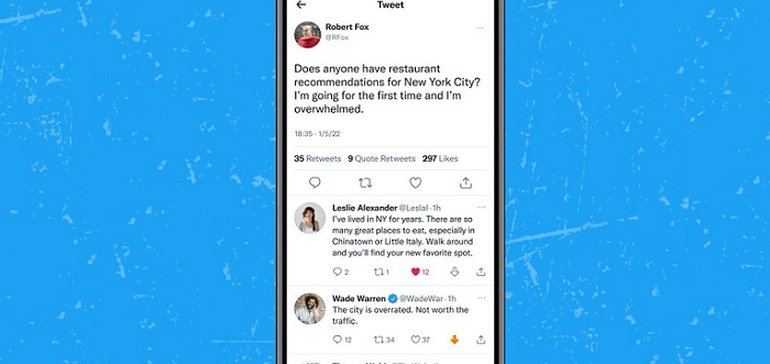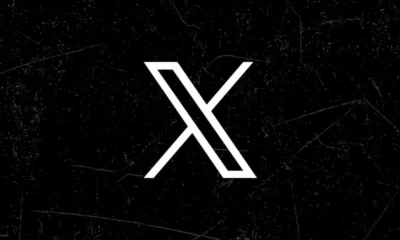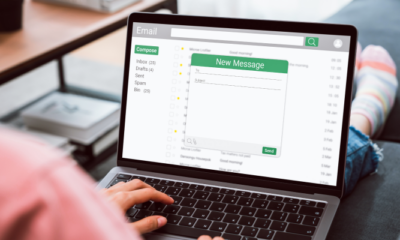SOCIAL
Twitter Expands Test of Downvotes on Tweet Replies to Glean More Insight into User Behavior

Twitter has announced that it’s expanding its test of downvotes on tweet replies, with more users on both iOS and Android set to see the new down arrow on tweet responses, providing another way to signal your thoughts on each comment.
As explained by Twitter:
“We learned a lot about the types of replies you don’t find relevant and we’re expanding this test – more of you on web and soon iOS and Android will have the option to use reply downvoting. Downvotes aren’t public, but they’ll help inform us of the content people want to see.”
Twitter initially launched its downvote test back in July, on iOS only, which many users saw as a ‘dislike’ option for tweet replies. Which Twitter says it isn’t, exactly.
“We’re hoping to better understand what people believe are relevant replies, and how that matches up to what Twitter suggests as most the relevant replies under a Tweet.”
So the idea is that these insights will help Twitter improve its algorithms to display the best replies under each tweet, these aren’t a measure of your personal response to a stated opinion nor are they designed to be a way to bury bad tweets, as they are on Reddit.
But in effect, that’s both how they work and what they’ll be used for – though Twitter has also provided some insight into the initial learnings that it’s gleaned from the first months of the test:
“A majority of our users shared that the reason they clicked the down arrow was either because the reply was perceived as offensive, or because they perceived it as not relevant, or both. This experiment also revealed that downvoting is the most frequently used way for people to flag content they don’t want to see. Finally, people who have tested downvoting agree it improves the quality of conversations on Twitter.”
In theory, Twitter’s downvote system is designed to push down spam and junk comments, but in reality, people are downvoting things that they find personally offensive and/or things they don’t want to see. Which could, of course, be seen as a form of censorship, especially if more people look to use the option to blitz dissenting opinions.
But maybe that’s what users want – the very act of using the downvote button on any reply is an intentional signal that you don’t like or want to see that type of content on the platform, in your own personal experience. The concept is not designed to moderate replies, as such, as dislike counts are not public, but it may end up serving as a way for Twitter to learn exactly the types of things that people hate. Which could improve the general quality of conversation in the app, but again, may be viewed as censorship.
Eventually, I can imagine some will see this as Twitter’s own form of ‘shadowbanning’, with their replies getting less exposure and engagement as a result of downvotes. But then again, it would also be very difficult for the tweet author to see how the process has impacted their comment, as they wouldn’t necessarily be able to view how it’s ranked in the overall reply chain.
The downvotes also aren’t on general tweets, just replies, which does reduce the overall impact. But Twitter could still look to incorporate what it learns from the test for its overall tweet ranking algorithm, which could impact general tweets also.
It’s an interesting test, and it is interesting to consider the Reddit model as a template of sorts for this, with Twitter even coloring its downvote button in Reddit orange.
Essentially, it serves a similar purpose to Reddit downvotes, in surfacing the most engaging, most interesting discussion points within each thread to boost user engagement. And maybe, if it is successful, Twitter could consider expanding downvotes to all tweets.
That would be a very interesting development. Twitter hasn’t suggested that it might be even considering this. But it could be the logical progression to boost user engagement.
That would be a game-changer for the platform, and the court of public opinion.
SOCIAL
Snapchat Explores New Messaging Retention Feature: A Game-Changer or Risky Move?

In a recent announcement, Snapchat revealed a groundbreaking update that challenges its traditional design ethos. The platform is experimenting with an option that allows users to defy the 24-hour auto-delete rule, a feature synonymous with Snapchat’s ephemeral messaging model.
The proposed change aims to introduce a “Never delete” option in messaging retention settings, aligning Snapchat more closely with conventional messaging apps. While this move may blur Snapchat’s distinctive selling point, Snap appears convinced of its necessity.
According to Snap, the decision stems from user feedback and a commitment to innovation based on user needs. The company aims to provide greater flexibility and control over conversations, catering to the preferences of its community.
Currently undergoing trials in select markets, the new feature empowers users to adjust retention settings on a conversation-by-conversation basis. Flexibility remains paramount, with participants able to modify settings within chats and receive in-chat notifications to ensure transparency.
Snapchat underscores that the default auto-delete feature will persist, reinforcing its design philosophy centered on ephemerality. However, with the app gaining traction as a primary messaging platform, the option offers users a means to preserve longer chat histories.
The update marks a pivotal moment for Snapchat, renowned for its disappearing message premise, especially popular among younger demographics. Retaining this focus has been pivotal to Snapchat’s identity, but the shift suggests a broader strategy aimed at diversifying its user base.
This strategy may appeal particularly to older demographics, potentially extending Snapchat’s relevance as users age. By emulating features of conventional messaging platforms, Snapchat seeks to enhance its appeal and broaden its reach.
Yet, the introduction of message retention poses questions about Snapchat’s uniqueness. While addressing user demands, the risk of diluting Snapchat’s distinctiveness looms large.
As Snapchat ventures into uncharted territory, the outcome of this experiment remains uncertain. Will message retention propel Snapchat to new heights, or will it compromise the platform’s uniqueness?
Only time will tell.
SOCIAL
Catering to specific audience boosts your business, says accountant turned coach

While it is tempting to try to appeal to a broad audience, the founder of alcohol-free coaching service Just the Tonic, Sandra Parker, believes the best thing you can do for your business is focus on your niche. Here’s how she did just that.
When running a business, reaching out to as many clients as possible can be tempting. But it also risks making your marketing “too generic,” warns Sandra Parker, the founder of Just The Tonic Coaching.
“From the very start of my business, I knew exactly who I could help and who I couldn’t,” Parker told My Biggest Lessons.
Parker struggled with alcohol dependence as a young professional. Today, her business targets high-achieving individuals who face challenges similar to those she had early in her career.
“I understand their frustrations, I understand their fears, and I understand their coping mechanisms and the stories they’re telling themselves,” Parker said. “Because of that, I’m able to market very effectively, to speak in a language that they understand, and am able to reach them.”Â
“I believe that it’s really important that you know exactly who your customer or your client is, and you target them, and you resist the temptation to make your marketing too generic to try and reach everyone,” she explained.
“If you speak specifically to your target clients, you will reach them, and I believe that’s the way that you’re going to be more successful.
Watch the video for more of Sandra Parker’s biggest lessons.
SOCIAL
Instagram Tests Live-Stream Games to Enhance Engagement

Instagram’s testing out some new options to help spice up your live-streams in the app, with some live broadcasters now able to select a game that they can play with viewers in-stream.
As you can see in these example screens, posted by Ahmed Ghanem, some creators now have the option to play either “This or That”, a question and answer prompt that you can share with your viewers, or “Trivia”, to generate more engagement within your IG live-streams.
That could be a simple way to spark more conversation and interaction, which could then lead into further engagement opportunities from your live audience.
Meta’s been exploring more ways to make live-streaming a bigger consideration for IG creators, with a view to live-streams potentially catching on with more users.
That includes the gradual expansion of its “Stars” live-stream donation program, giving more creators in more regions a means to accept donations from live-stream viewers, while back in December, Instagram also added some new options to make it easier to go live using third-party tools via desktop PCs.
Live streaming has been a major shift in China, where shopping live-streams, in particular, have led to massive opportunities for streaming platforms. They haven’t caught on in the same way in Western regions, but as TikTok and YouTube look to push live-stream adoption, there is still a chance that they will become a much bigger element in future.
Which is why IG is also trying to stay in touch, and add more ways for its creators to engage via streams. Live-stream games is another element within this, which could make this a better community-building, and potentially sales-driving option.
We’ve asked Instagram for more information on this test, and we’ll update this post if/when we hear back.
-

 PPC5 days ago
PPC5 days ago19 Best SEO Tools in 2024 (For Every Use Case)
-

 MARKETING7 days ago
MARKETING7 days agoStreamlining Processes for Increased Efficiency and Results
-
SEARCHENGINES6 days ago
Daily Search Forum Recap: April 17, 2024
-

 PPC7 days ago
PPC7 days ago97 Marvelous May Content Ideas for Blog Posts, Videos, & More
-

 SEO7 days ago
SEO7 days agoAn In-Depth Guide And Best Practices For Mobile SEO
-
SEARCHENGINES5 days ago
Daily Search Forum Recap: April 18, 2024
-

 MARKETING6 days ago
MARKETING6 days agoEcommerce evolution: Blurring the lines between B2B and B2C
-
SEARCHENGINES4 days ago
Daily Search Forum Recap: April 19, 2024
















You must be logged in to post a comment Login